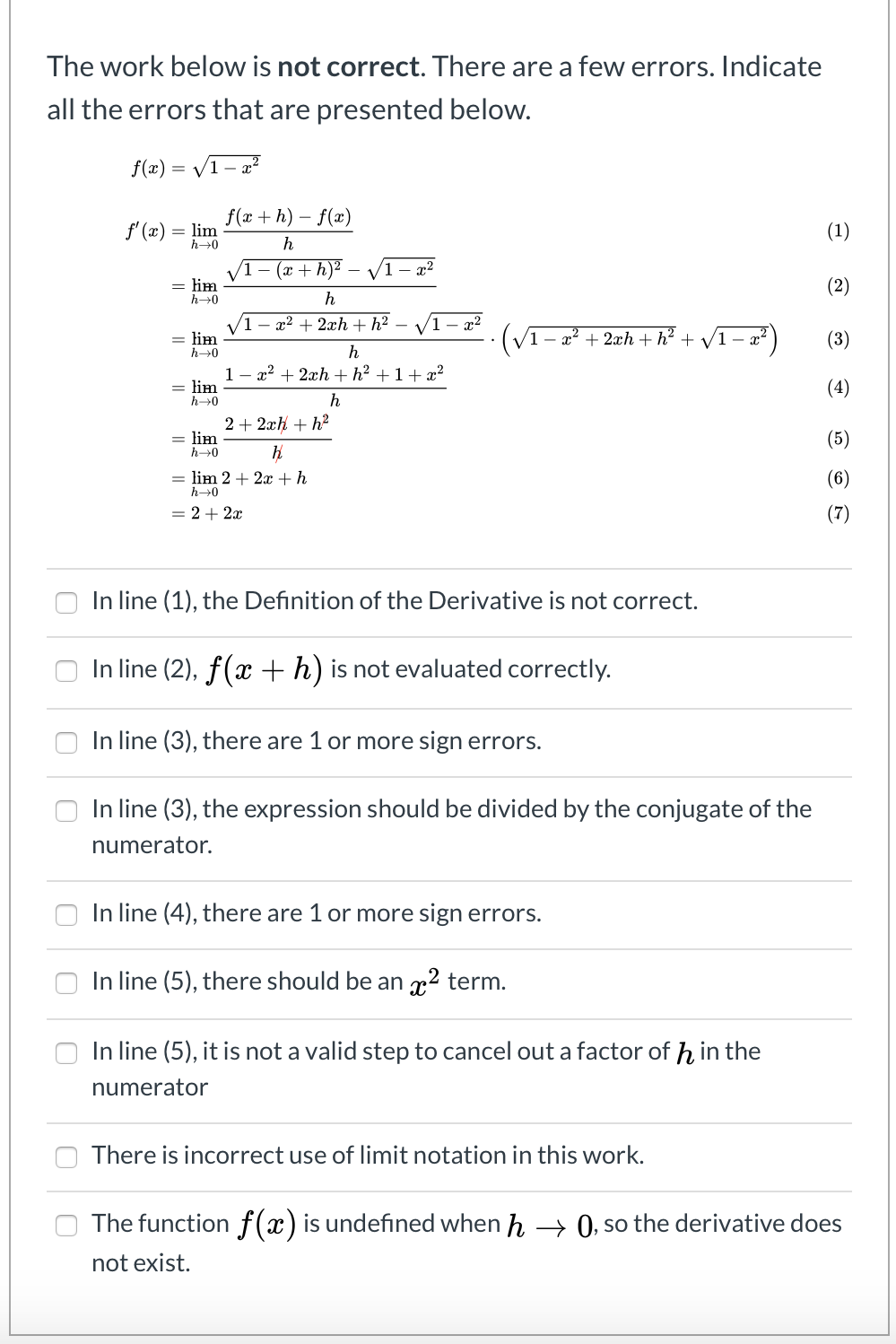The work below is not correct. There are a few errors. Indicate all the errors that are presented below. f(x) = V1– a? f(x + h) – f(x) = lim h→0 f' (x) (1) h - (x + h)² – V1 - 72 = lim h→0 (2) h 1 – x² + 2xh + h² – /1 – x² V lim h→0 (V1 – x² + 2xh + h² + /1 – æ² (3) 1- x2 + 2xh + h² + 1+ x2 = lim h→0 (4) h 2+ 2xh + h² = lim h→0 (5) = lim 2 + 2x + h h→0 (6) = 2 + 2x (7) In line (1), the Definition of the Derivative is not correct. In line (2), f(x +h) is not evaluated correctly. In line (3), there are 1 or more sign errors. In line (3), the expression should be divided by the conjugate of the numerator. In line (4), there are 1 or more sign errors. In line (5), there should be an x² term. In line (5), it is not a valid step to cancel out a factor of h in the numerator There is incorrect use of limit notation in this work.
The work below is not correct. There are a few errors. Indicate all the errors that are presented below. f(x) = V1– a? f(x + h) – f(x) = lim h→0 f' (x) (1) h - (x + h)² – V1 - 72 = lim h→0 (2) h 1 – x² + 2xh + h² – /1 – x² V lim h→0 (V1 – x² + 2xh + h² + /1 – æ² (3) 1- x2 + 2xh + h² + 1+ x2 = lim h→0 (4) h 2+ 2xh + h² = lim h→0 (5) = lim 2 + 2x + h h→0 (6) = 2 + 2x (7) In line (1), the Definition of the Derivative is not correct. In line (2), f(x +h) is not evaluated correctly. In line (3), there are 1 or more sign errors. In line (3), the expression should be divided by the conjugate of the numerator. In line (4), there are 1 or more sign errors. In line (5), there should be an x² term. In line (5), it is not a valid step to cancel out a factor of h in the numerator There is incorrect use of limit notation in this work.
College Algebra
7th Edition
ISBN:9781305115545
Author:James Stewart, Lothar Redlin, Saleem Watson
Publisher:James Stewart, Lothar Redlin, Saleem Watson
Chapter3: Polynomial And Rational Functions
Section3.6: Rational Functions
Problem 2E
Related questions
Question

Transcribed Image Text:The work below is not correct. There are a few errors. Indicate
all the errors that are presented below.
f(x) = V1– a?
f(x + h) – f(x)
= lim
h→0
f' (x)
(1)
h
- (x + h)² – V1
- 72
= lim
h→0
(2)
h
1 – x² + 2xh + h² – /1 – x²
V
lim
h→0
(V1 – x² + 2xh + h² + /1 – æ²
(3)
1- x2 + 2xh + h² + 1+ x2
= lim
h→0
(4)
h
2+ 2xh + h²
= lim
h→0
(5)
= lim 2 + 2x + h
h→0
(6)
= 2 + 2x
(7)
In line (1), the Definition of the Derivative is not correct.
In line (2), f(x +h) is not evaluated correctly.
In line (3), there are 1 or more sign errors.
In line (3), the expression should be divided by the conjugate of the
numerator.
In line (4), there are 1 or more sign errors.
In line (5), there should be an x² term.
In line (5), it is not a valid step to cancel out a factor of h in the
numerator
There is incorrect use of limit notation in this work.
Expert Solution
This question has been solved!
Explore an expertly crafted, step-by-step solution for a thorough understanding of key concepts.
This is a popular solution!
Trending now
This is a popular solution!
Step by step
Solved in 3 steps with 3 images

Knowledge Booster
Learn more about
Need a deep-dive on the concept behind this application? Look no further. Learn more about this topic, calculus and related others by exploring similar questions and additional content below.Recommended textbooks for you

College Algebra
Algebra
ISBN:
9781305115545
Author:
James Stewart, Lothar Redlin, Saleem Watson
Publisher:
Cengage Learning

College Algebra
Algebra
ISBN:
9781305115545
Author:
James Stewart, Lothar Redlin, Saleem Watson
Publisher:
Cengage Learning